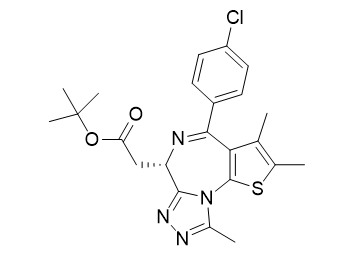(+)-JQ1
(+)-JQ1 is a BET bromodomain inhibitor, with IC50 of 77 nM/33 nM for BRD4(1/2) in cell-free assays, binding to all bromodomains of the BET family, but not to bromodomains outside the BET family. (+)-JQ1 suppresses cell proliferation via inducing autophagy.
Inquire / Order:
manager@chemfaces.com
Technical Inquiries:
service@chemfaces.com
Tel:
+86-27-84237783
Fax:
+86-27-84254680
Address:
1 Building, No. 83, CheCheng Rd., Wuhan Economic and Technological Development Zone, Wuhan, Hubei 430056, PRC
Providing storage is as stated on the product vial and the vial is kept tightly sealed, the product can be stored for up to
24 months(2-8C).
Wherever possible, you should prepare and use solutions on the same day. However, if you need to make up stock solutions in advance, we recommend that you store the solution as aliquots in tightly sealed vials at -20C. Generally, these will be useable for up to two weeks. Before use, and prior to opening the vial we recommend that you allow your product to equilibrate to room temperature for at least 1 hour.
Need more advice on solubility, usage and handling? Please email to: service@chemfaces.com
The packaging of the product may have turned upside down during transportation, resulting in the natural compounds adhering to the neck or cap of the vial. take the vial out of its packaging and gently shake to let the compounds fall to the bottom of the vial. for liquid products, centrifuge at 200-500 RPM to gather the liquid at the bottom of the vial. try to avoid loss or contamination during handling.
Sci Rep.2018, 8:15059
Free Radic Biol Med.2021, 166:104-115.
Food and Chemical Toxicology2020, 111221
J Insect Sci.2020, 20(5):18.
Food Bioscience2023, 59:103903
J Pharmaceut Biomed2020, 178:112894
J Mol Recognit.2020, 33(2):e2819
Metabolites.2019, 9(11):E271
Front Cell Dev Biol.2021, 9:764263.
Nat Commun.2023, 14(1):4540.
Related and Featured Products
Proc Natl Acad Sci U S A,2011 Oct 4;108(40):16669-74.
Targeting MYC dependence in cancer by inhibiting BET bromodomains.[Pubmed:
21949397]
The MYC transcription factor is a master regulator of diverse cellular functions and has been long considered a compelling therapeutic target because of its role in a range of human malignancies. However, pharmacologic inhibition of MYC function has proven challenging because of both the diverse mechanisms driving its aberrant expression and the challenge of disrupting protein-DNA interactions.
METHODS AND RESULTS:
Here, we demonstrate the rapid and potent abrogation of MYC gene transcription by representative small molecule inhibitors of the BET family of chromatin adaptors. MYC transcriptional suppression was observed in the context of the natural, chromosomally translocated, and amplified gene locus. Inhibition of BET bromodomain-promoter interactions and subsequent reduction of MYC transcript and protein levels resulted in G(1) arrest and extensive apoptosis in a variety of leukemia and lymphoma cell lines. Exogenous expression of MYC from an artificial promoter that is resistant to BET regulation significantly protected cells from cell cycle arrest and growth suppression by BET inhibitors. MYC suppression was accompanied by deregulation of the MYC transcriptome, including potent reactivation of the p21 tumor suppressor. Treatment with a BET inhibitor resulted in significant antitumor activity in xenograft models of Burkitt's lymphoma and acute myeloid leukemia.
CONCLUSIONS:
These findings demonstrate that pharmacologic inhibition of MYC is achievable through targeting BET bromodomains. Such inhibitors may have clinical utility given the widespread pathogenetic role of MYC in cancer.
Cell,2011 Sep 16;146(6):904-17.
BET bromodomain inhibition as a therapeutic strategy to target c-Myc.[Pubmed:
21889194]
MYC contributes to the pathogenesis of a majority of human cancers, yet strategies to modulate the function of the c-Myc oncoprotein do not exist.
METHODS AND RESULTS:
Toward this objective, we have targeted MYC transcription by interfering with chromatin-dependent signal transduction to RNA polymerase, specifically by inhibiting the acetyl-lysine recognition domains (bromodomains) of putative coactivator proteins implicated in transcriptional initiation and elongation. Using a selective small-molecule bromodomain inhibitor, JQ1, we identify BET bromodomain proteins as regulatory factors for c-Myc. BET inhibition by JQ1 downregulates MYC transcription, followed by genome-wide downregulation of Myc-dependent target genes.
CONCLUSIONS:
In experimental models of multiple myeloma, a Myc-dependent hematologic malignancy, JQ1 produces a potent antiproliferative effect associated with cell-cycle arrest and cellular senescence. Efficacy of JQ1 in three murine models of multiple myeloma establishes the therapeutic rationale for BET bromodomain inhibition in this disease and other malignancies characterized by pathologic activation of c-Myc.
Nature, 2010 Dec 23;468(7327):1067-73.
Selective inhibition of BET bromodomains.[Pubmed:
20871596]
Cell lines:MC 11060 cells
Concentrations: ~500 nM
Incubation Time: 48 hours
Method:
Cells are seeded into white, 384-well microtiter plates at 500 cells per well in a total volume of 50 μL media. The 797, TT and TE10 cells are grown in DMEM containing 1% penicillin/streptomycin and 10% FBS. The Per403 cells are grown in DMEM containing 1 % penicillin/streptomycin and 20% FBS. Patient-derived NMC 11060 cells are grown in RPMI with 10% FBS and 1% penicillin/streptomycin. (+)-JQ1 is delivered to microtiter assay plates by robotic pin transfer. Following a 48 hours incubation at 37℃, cells are lysed and wells are assessed for total ATP content using a commercial proliferation assay. Replicate measurements are analyzed with respect to dose and estimates of IC50 are calculated by logistic regression (GraphPad Prism).



